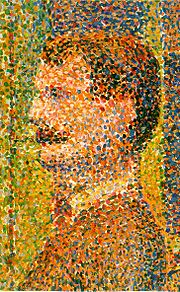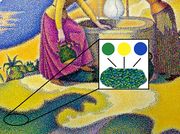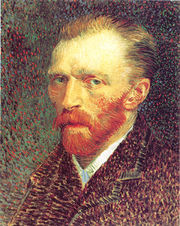Pointillism

Pointillism is a technique of painting in which small, distinct dots of pure color are applied in patterns to form an image. Georges Seurat developed the technique in 1886, branching from Impressionism. The term Pointillism was first coined by art critics in the late 1880s to ridicule the works of these artists and is now used without its earlier mocking connotation.[1]
Contents |
Technique
The technique relies on the perceptive ability of the eye and mind of the viewer to mix the color spots into a fuller range of tones and is related closely to Divisionism, a more technical variant of the method. Divisionism is concerned with color theory, where pointillism is more focused on the specific style of brushwork used to apply the paint.[1] It is a technique with few serious practitioners and is notably seen in the works of Seurat, Signac and Cross.

The practice of Pointillism is in sharp contrast to the more common methods of blending pigments on a palette or using the many commercially available premixed colors. Pointillism is analogous to the four-color CMYK printing process used by some color printers and large presses, Cyan (blue), Magenta (red), Yellow and Key (black). Televisions and computer monitors use a pointillist technique to represent images but with Red, Green, and Blue (RGB) colors.
Neuroplasticity is a key element of observing a pointillistic image. While two individuals will observe the same photons reflecting off a photorealistic image and hitting their retinas, someone whose mind has been primed with the theory of pointillism will see a very different image as the image is interpreted in the visual cortex.[2]
Practice
If red, blue and green light (the additive primaries) are mixed, the result is something close to white light. The brighter effect of pointillist colours could rise from the fact that subtractive mixing is avoided and something closer to the effect of additive mixing is obtained even through pigments.
The painting technique used to perform pointillistic color mixing is at the expense of traditional brushwork which could be used to delineate texture.
The majority of pointillism is done in oil paints, but is not required. Anything may be used in its place, however it is used for its thickness and ability to not run or bleed.[3]
Music
Pointillism also refers to a style of 20th-century music composition. It is stylized in the same texture, in that different musical notes are done in seclusion rather than in a linear sequence.[4] This type of music is referred to as punctualism or klangfarbenmelodie.
Notable artists

- Georges-Pierre Seurat
- Paul Signac
- Henri-Edmond Cross
- John Roy
- Maximilien Luce
- Vincent van Gogh
- Camille Pissarro
- Théo van Rysselberghe
- Chuck Close
- Georges Lemmen
Notable Paintings
- A Sunday Afternoon on the Island of La Grande Jatte by Georges Seurat
- Bathing at Asnieres by Georges Seurat
- The Windmills at Overschie by Paul Signac
- Banks of Seine by Georges Seurat
- Une baignade, Asnières by Georges Seurat
- A Coastal Scene by Theo Van Rysselberghe
- Family in the Orchard by Theo Van Rysselberghe
- Countryside at Noon by Theo Van Rysselberghe
- Afternoon at Pardigon by Henri-Edmond Cross
- Rio San Trovaso, Venice by Henri-Edmond Cross
- The Seine in front of the Trocadero by Henri-Edmond Cross
- The Pine Tree at St. Tropez by Paul Signac
- Against the Enamel of Background Rhythmic with Beats and Angels by Paul Signac
- The Yellow Sail, Venice by Paul Signac
- Notre Dame Cathedral by Maximilien Luce
- Le Pont De Pierre, Rouen by Charles Angrand
- The Beach at Heist by Georges Lemmen
- Aline Marechal by Georges Lemmen
- Vase of Flowers by Georges Lemmen
See also
- Neo-Impressionism
- Stippling
- Divisionism
- Punctualism
References
- ↑ 1.0 1.1 "Pointillism ." Artcyclopedia. Artists by Movement. John Malyon/Artcyclopedia,, 2007. Web. http://www.artcyclopedia.com/history/pointillism.html
- ↑ Schwartz, Jeffrey M.; Begley, Sharon (2003). The Mind and the Brain: Neuroplasticity and the Power of Mental Force. Harper Perennial. pp. 337. ISBN 0060988479.
- ↑ Nathan, Solon. "Pointillism Materials." Web. 9 Feb 2010. http://www.si.umich.edu/chico/emerson/pntmat.html
- ↑ Britannica - The Online Encyclopedia http://www.britannica.com/
External link
|
|||||||||||
|
|||||||||||||||||||||||